Performance Midrange Common Components
While AMD and Intel architectures differ in sockets and sometimes memory configurations, more is the same than not with the two systems. For that reason the Intel and AMD value midrange systems share a number of common components.
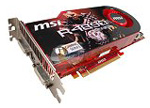 |
If you refer to the recent launch article on the ATI 4890 and NVIDIA GTX 275, you will find these two cards were initially the new choices for the $250 price point. Since then the very popular ATI 4890 has seen tremendous price competition among those selling the card. As a result, an overclocked 4890 can be had for $170 today after $30 rebate. While the GTX 275 performs similarly, it remains around the $250 selling price, with an occasional rebate pushing the price near $200. That is the reason the MSI 4890 OC is the video card choice for both performance midrange systems.
If you prefer NVIDIA cards or NVIDIA drivers, the GTX 275 is an easy substitute in either system. Either card will do the job well and you can shop based on price. The edge goes to the ATI 4890 in the resolutions you will likely run (1920x1200 or lower) with a 27" or smaller display. If you have a 30" monitor, the GTX 275 performs a bit better at those super high resolutions.
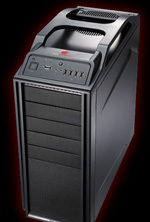 |
The case receives a significant upgrade with the selection of the unique Cooler Master Storm Scout mid-tower case. The Scout has many endearing features, but we would point out the unique rear cutout behind the CPU on the motherboard tray. That makes it possible to install many "through-the-board" aftermarket CPU heatsinks without removing the motherboard. It's a truly clever and useful design element, and we'd like to see more cases support such a feature. The top-mount handle and quiet, effective cooling are also big pluses. Some also want a unique appearance and the Storm Scout delivers with its red LED glow in a distinctive looking case.
Alternates are the Antec Nine Hundred at about the same price and the Antec 902 or Cooler Master Storm Sniper at $160. Both alternatives are very popular with system builders and buyers praise the build quality of both cases.
 |
AnandTech and many other review sites have praised the solid construction, performance, and value of Corsair power supplies. It should come as no surprise that the Corsair 750TX is the choice to power either performance midrange system. The power supply is SLI Ready and CrossFire Ready, 80 PLUS Certified, and Core i7 ready. Power is delivered to a single 60A 12V rail for those looking for that feature and finding it hard to come by at a reasonable price. With a $20 rebate the final cost is $100, which is a great value for a PSU with these specifications, features, and performance reputation.
Most of our editors consider the onboard audio of motherboards to be more than adequate for even gaming these days. That is why we have not chosen a sound card for the performance midrange system. If you want more than onboard surround sound then we recommend the Auzentech X-Fi Forte 7.1 for serious gaming at $140. HTPC users will find much to like in the ASUS Xonar HDAV 1.3 Slim. Other good choices are the ASUS Xonar Essence STX for music, in particular for serious headphone users, or the HT Omega Claro Halo - both run about $200. If you are looking for a good general purpose onboard audio upgrade the HT Omega Striker 7.1 should fit your needs at around $90.
 |
The optical drive for a performance midrange system needs the ability to play Blu-Ray disks. A new model was chosen here with the faster 8X BD read speeds, the LG CH08LS10 Blu-Ray/DVD combo drive. In addition to 8X BD and BD dual-layer playback, you can burn DVDs as fast as 16X single-layer or 12X DL. It cannot, however, burn 25GB/50GB Blu-Ray disks. Adding that capability increases the cost to around $200 to $250. BD burners like the $200 LITE-ON 4X BD-R SATA burner or the $230 LG GGW-H20LK 6X Blu-ray burner are good choices.
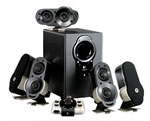 |
Speakers have been upgraded to the Logitech G51 155W RMS 5.1 surround sound speakers. The Logitech rebate has ended, but you can still find the G51 for as little as $120 if you shop, which makes the G51 an excellent value.
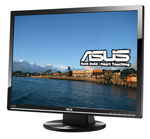 |
The LCD display resolution maintains the 1920 horizontal pixels of 1080p displays but moves to a 26" WUXGA display with a 1200 pixel height. Whatever the minor resolution differences the size of the monitor is increased to a nominal 26" so everything on screen is a little larger (0.292mm pixel pitch). The ASUS VW266H 25.5" HDMI widescreen provides the preferred HDMI input, as well as DVI and an analog VGA port. Panel speed is rated at an incredible 2ms, but we have found most current LCD panels perform similarly and the speed rating does not really guarantee very much. The ASUS monitor provides a large sharp image, good colors, and fast panel speed at a very good price of $300 after rebate. It comes with DVI and VGA cables, but if you plan to connect with HDMI you will need to buy an HDMI cable.
As most readers are aware, LCD panels have been going to cheaper panel technologies and generally declining in image quality. Despite that fact, most buyers are reporting that they are pleased with current LCD screens. It you have a need for exceptional color or yours is a mission-critical graphics task, you may want to look at the HP LP2475w 24" 1920x1200 monitor. This HP monitor is likely the best quality 24" monitor you can buy today, with superior panel technology (S-IPS) and image quality likely to satisfy graphics professionals.
The remaining components are the same as our value systems. The hard drive remains a 1TB WD. The Microsoft OEM keyboard and optical mouse provide input and Vista Home Premium OEM runs the system. For more information on these components you can refer to descriptions on p.3.
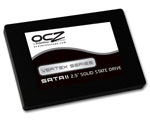 |
In response to those who have asked for SSD recommendations, it is possible to do so based on the months of research and testing performed on SSD drives at AnandTech. For more information on SSD test results please see our SSD Anthology and our SSD update. As we recently reported, you should be on the lookout for further price reductions expected in the next few weeks. The short summary is that the new Intel X25-M G2 SSDs are the top performers, but the price-reduced Indilinx options like the OCZ Vertex and OCZ Agility are viable competitors.










71 Comments
View All Comments
Black Jacque - Monday, July 27, 2009 - link
>For instance there are hardly any quality power supplies in the 450->550W range that offer 2 6-pin PCIe connectors (a requirement to run >HD 4870/90 and GTX 260/275 cards).Like the Seasonic S12II-430 Bronze (1xPCIe-6, 1xPCIe-6+2)?
In addition, most GPUs come with a Power Cable to adapt the standard Molex to PCIe-6. The recommended MSI HD 4890 comes with two Power Cables.
> it makes good long term sense to throw in another $25 and get a >more powerful PS for your future upgrade needs.
The Xbit Labs article clearly states the trend in PC parts power consumption is downward, not upward. Besides, I'd rather not spend US$25 that I didn't have to. I could use that money to upgrade to a Q9400 or an E8500, something I could use rightaway.
Nfarce - Monday, July 27, 2009 - link
"Like the Seasonic S12II-430 Bronze (1xPCIe-6, 1xPCIe-6+2)? "Not real familiar with that brand. Try finding one in the range I mentioned built by Antec, Corsair, OCZ, Thermaltake, or PC Power & Cooling. And 430W? I have that in a five year old P4 system. I don't think so. I'll spend the extra few clams on something future proof, and apparently others agree. If you have to worry about spending another $25 on an $850+ PC build, then maybe you need to reconsider your spending priorities.
Black Jacque - Monday, July 27, 2009 - link
>Not real familiar with that brand. Try finding one in the range I >mentioned built by Antec, Corsair, OCZ, Thermaltake, or PC Power & >Cooling.Seasonic can be found providing OEM service on various model lines for: Antec, Corsair, PC Power and Cooling, and of course under their own Seasonic brand. Actually, the PSUs that Seasonic either designs or builds for Antec, Corsair or the old PCP&P are not as high quality as the PSUs they build under their own brand label.
Nfarce - Tuesday, July 28, 2009 - link
Thanks for the info Black Jacque. I did not know that, and I now verified that fact. Of all the PS research I did prior to my build, no reviews mentioned that fact. However, I will still stand by spending a little more on a future proof power supply so as one less thing to have to upgrade. My Corsair 750W will take me into next year's planned Lynnfield build and the new DX11 cards with SLI (hopefully).haplo602 - Monday, July 27, 2009 - link
the article is one from the "how much power do we need" round that almost every major hardware review site did.however it was more or less questioning the need of 700+ W PSUs for the normal systems (i.e. average home PC).
you have to account also for the usage pattern. this site is aimed at the hardware enthusiasts. they tend to buy informed or tend to change components often. in the first case, they will ignore the PSU recommendation, in the 2nd case, it comes in handy in the future.
also have a look at power consumption on overclocked components (f.e. CPUs increase quite dramaticaly with added voltage). IIRC the xbitlabs article did not take into account overclocking (I might be wrong, did not read into details there).
brybir - Monday, July 27, 2009 - link
You keep referring to that article and after raeding it I do find it interesting. But all it says is that usage is trending downword. That trend is based on events that have already happened and then assuming what future events will occur with power draw based off similar past events.First, just because the trend is in one direction does not mean that it is going to continue that way in the future. That is to say that the past predicts the future which is simply not true.
Second, it makes sense to me to spend $25 on a larger power supply than I need "right now" so that I do not have to worry about replacing the power supply later on. You can say that the general power draw will decrease over time but in each individual case that is not going to be necessarily true. I just went from a system with a 65W CPU and a ATI 4670 to a 125W CPU and a 4870 OC using the same power supply. Had I bought the power supply that exactly fit my previous system I would now have to buy a new power supply. So in my case buying a larger power supply has been a great idea and will save me from spending another $70 this time around. Who knows, since its a 550W supply maybe it will last me another three years.
Black Jacque - Monday, July 27, 2009 - link
>First, just because the trend is in one direction does not mean that >it is going to continue that way in the future. That is to say that >the past predicts the future which is simply not true.You are joking, right?
http://products.amd.com/en-us/DesktopCPUDetail.asp...">http://products.amd.com/en-us/DesktopCPUDetail.asp...
If you understand how the past can predict the future, its no surprise that AMD improved their process and shaved 30W off this part's (AMD Phenom™ II X4 945) power consumption after a bit more than 5-months of production. (BTW, this part costs US$1 more than its 125W sibling at ZZF.)
Looking into my crystal ball, I predict ~3 GHz 65W quad CPUs by either AMD or Intel within a year.
haplo602 - Monday, July 27, 2009 - link
each system has at least a 2x PCIex16 board, so the higher watt PSU is an "insurance" for future upgrades.anyway the builds are unbalanced in my view. they get away with far too cheap displays.
my current planed build is 1:1 in components vs lcd cost. My total component cost is about 600 euro, the display will cost me around 500 euro :-)
but I am more looking at photo editing than gaming.
Black Jacque - Monday, July 27, 2009 - link
>so the higher watt PSU is an "insurance" for future upgrades."The recent, excellent Xbit Labs article "PC Power Consumption: How Many Watts Do We Need?" clearly illustrates that 750W PSUs are a waste of money in the mid-range when not going with SLI or Crossfire. This article shows the trend in PC parts is downward in power consumption."
I can't even accept the idea of adding a second GPU later when they get less expensive. The general trend is the next generation of GPU outperforms the previous generation in Crossfire or SLI at a lower price.
erple2 - Monday, July 27, 2009 - link
I suppose that's true. However, it's also true that the next generation of GPU also tends to consume more power than the previous generation. Normally, not 2x the power, but 20-50% more power isn't unheard of.Though, you're right. Buying a power supply strictly because it makes the PSU itself a little bit more future proof doesn't necessarily make that much sense. How often does the midrange buyer upgrade their systems? Every 2 years? 3 years? What's the reasonable lifetime of a PSU? 3 years? 5 years? Is it enough to last through a full upgrade cycle? If the answer is "yes", then it's certainly possible that buying a slightly higher end power supply can be worth it. You pay the extra 25 dollars now, but save 75 dollars for the next upgrade.
Unless the next generation of chips use less power than the current gen, which I don't think is going to be the case (the only exception that I can think of in the x86 world was the move from Pentium 4 to Core2Duo), then buying a slightly larger power supply than necessary isn't necessarily a bad idea. Now, going with 750 Watts with a non-SLI, non-XFire setup does seem a bit silly.
If you overclock, I don't know how that impacts the power consumption of the system, either. Maybe a study on that would be interesting?